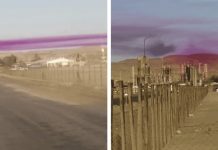This massive and unusual Morning Glory phenomenon was captured during flight VA714 from Perth to Adelaide by Ilya Katsman on 06.01.2017.
The Morning Glory cloud is not clearly understood because their rarity. Sometimes there is only one cloud, sometimes there are up to ten consecutive roll clouds. But here we have more than 20! Anomalous!

A Morning Glory cloud is a roll cloud, or arcus cloud, that can be up to 1,000 kilometres (620 mi) long and 1 to 2 kilometres (0.62 to 1.24 mi) high. They often only float 100 to 200 metres (330 to 660 ft) above the ground. The cloud often travels at the rate of 10 to 20 metres per second.
The Morning Glory cloud is a rare meteorological phenomenon consisting of a low-level atmospheric solitary wave and associated cloud. The wave often occurs as an amplitude-ordered series of waves forming bands of roll clouds.

The southern part of the Gulf of Carpentaria in Northern Australia is the only known location where it can be predicted and observed on a more or less regular basis due to the configuration of land and sea in the area.
Well, a giant 800km-long morning glory was captured in Queensland, recently.
The Morning Glory is often accompanied by sudden wind squalls, intense low-level wind shear, a rapid increase in the vertical displacement of air parcels, and a sharp pressure jump at the surface. The cloud is continuously formed at the leading edge while being eroded at the trailing edge.

Showers or thunderstorms may develop in its wake. In the front of the cloud, there is strong vertical motion that transports air up through the cloud and creates the rolling appearance, while the air in the middle and rear of the cloud becomes turbulent and sinks. The cloud quickly dissipates over land where the air is drier.
Unusual cloud formations have been noticed in Australia since ancient times. The local Garrawa Aboriginal people called it kangólgi. Royal Australian Air Force pilots first reported this phenomenon in 1942.

The Morning Glory cloud is not clearly understood because their rarity.












